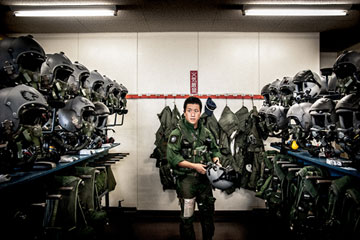
These days, Japanese pilot Kohta "Vader" Araki, who flies F-15s, is always on alert.
(7 of 7)
That spooks many Okinawans, who inhabit what was once a kingdom called Ryukyu that paid tribute to imperial China. By the late 19th century, though, Okinawa had been absorbed into Japan. (Chinese academics and military officers have postulated that China has territorial rights not just to the Senkaku-Diaoyu Islands but to all of Okinawa.) At the end of World War II, in the horrific Battle of Okinawa, the Japanese military forced tens of thousands of Okinawans into combat, some even compelled to commit suicide in the face of the Allied assault. Local animosity toward Japanese troops, even under the guise of the SDF, lingers--not to mention discomfort with the 25,000 Americans on U.S. military bases on Okinawan soil. "Japan is a very scary country, a warrior culture," says former Okinawa governor Masahide Ota. "The most important lesson from the Battle of Okinawa is that the Japanese military will never protect the local people."
On the island of Ishigaki, which has administrative jurisdiction over what Japan calls the Senkaku, Mayor Yoshitaka Nakayama appears open to building an SDF base to better protect the disputed islets. "I am concerned that China is trying to expand its territorial interests," he says. "Since such a country exists in our neighborhood, we have to enhance our defense." Kameichi Uehara, head of the local fishermen's union, doesn't see the threat. "I've never heard of any Chinese boats giving any trouble to us." Local historian Shizuo Ota concurs. "I don't think China has provoked the Senkaku issue," he says. "It's rightist groups from Japan that are causing most of the problems."
Japan's vocal rightists, who like to tool around Tokyo in vans that broadcast historical whitewashing, don't help with Japan's international image. "Ask anyone," says Nariaki Nakayama, a conservative lawmaker, "and they will say that the Japanese are a peace-loving people who want to avoid war." But Nakayama also denies that the Rape of Nanjing happened and believes that "comfort women" are a myth. One controversial Abe supporter is Toshio Tamogami, a retired SDF general who had to resign as head of the Air Self-Defense Force in 2008 after denying that Japan was an aggressor in World War II. He now helps lead an ultra-right-wing group called Ganbare Nippon, or "Go for It, Japan," which has staged illegal landings on the Senkaku-Diaoyu Islands. "Abe is completely different from his predecessors," says Ganbare Nippon president Satoru Mizushima, who swam from a boat to the disputed islets last year. "He may be thinking, Please, put your hands on the Senkaku. It will open the door to protecting our country by ourselves."
In July, Abe visited Miyako while on the campaign trail for the upper-house election. Base commander Lieut. Colonel Yasumasa Hayashi can't remember too much of what the Prime Minister said when he praised the troops for being a "cornerstone of intelligence, surveillance and reconnaissance" for the region. "I was too nervous to be meeting my commander in chief," Hayashi admits. "But I feel great pride to be serving on the front lines of Japan." Standing on a helicopter-landing pad at his tiny military outpost, Hayashi gazes out at the East China Sea. Just 125 miles away are the disputed islands that have caused such friction between Japan and China. The seas are calm--for now.
--With reporting by Chie Kobayashi/Naha Air Base
